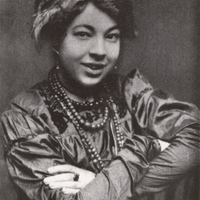Golden Dawn Symbolism in Tarot's Trumps
Rider-Waite-Smith Tarot
The Rider-Waite-Smith Tarot is the joint creation of Arthur Edward Waite and Pamela Coleman Smith, two former Golden Dawn members in 1909, which was soon after published by the Rider Press in 1910.^{6} The deck, which was illustrated by Smith, features a considerable amount of symbolism that is concurrent with the former occultist group. A selection of the twenty-two trumps in particular are the focus of this exhibit, and how their pictorial representations have evolved from playing cards of the mid fifteenth century to occultist ideograms that are familiar to us today.
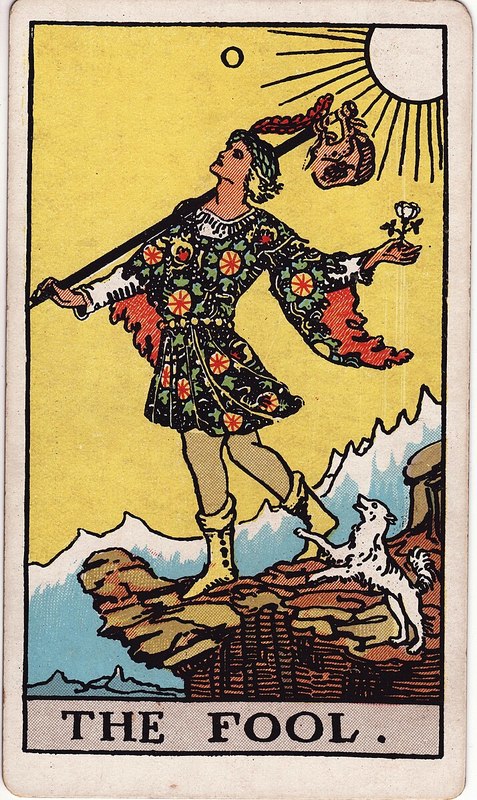
The Fool
The Fool represents the neophyte, a newly initiated member of the Order of the Golden Dawn. Being the first card amongst the trumps, it is interestingly numbered at "0" instead of the usual "1". Initiates in the order were assigned the number "0", as they were just beginning their journey to enlightenment, and therefore started as 0, as nothing, or as a fool. ^{7} Waite's depiction of the card describes a woeful dreamer who has yet to begin his journey into the world. He writes in his description of the card that the “fool signifies the flesh, the sensitive life, and by a peculiar satire its subsidiary name was at one time the alchemist, as depicting folly at the most insensate stage.”^{8} Insensate, meaning lacking sensation or numb, is an interesting choice to describe the beginning stages of an initiate's journey. This wording points to the fact that the initiate is unaware, or numb to the truths and the hidden knowledge to be learnt through the ranks of the Golden Dawn. The imagery within the card also points to this attribution, with the figure on the cliff having their eyes closed, blissfully unaware of the steep drop directly in front of them. According to another Golden Dawn source, this fool is the crown of wisdom. ^{9} This association would indicate that although the initiate is currently assigned to the baseline number "0", there is bountiful wisdom to be revealed as they are initiated.
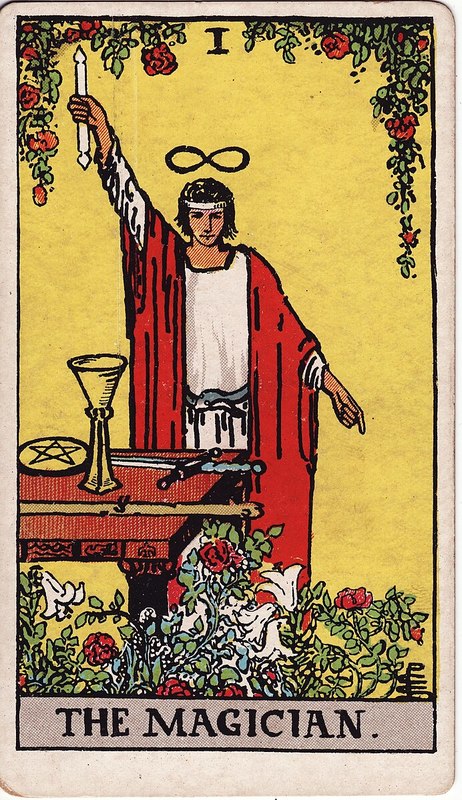
The Magician
Represented by the number "1", the Magician falls after the Fool and depicts an initiate who has begun their journey with the Golden Dawn. The figure in the card has the sign of infinity residing above their head, and a serpent with its head eating its tail wrapped around its waist, which is another symbol of infinity. According to Waite, these symbols represent the sign of life, or an endless cord. ^{10} By this he means that the journey of spiritual attainment is eternal. The card also feature the four suits, or elements of the tarot deck on the table. The Magician, through trances and meditation with the Golden Dawn has the ability to master these four elements at will. ^{11} Initiates in the Golden Dawn were taught how to "evoke" subconscious energies, as well as "invoke" divine energies to aid in raising their awareness. Continuous practice allowed one to rise through the grades, and master these elements. Waite also mentions that the figure within the card has the countenance of the Greek deity Apollo. This reference reflects how in the final grades of the Golden Dawn an initiate becomes a highly spiritual, god-like being, akin to angels. The directions in which the figure is pointing is a reference to the Golden Dawn adage: "as above, so below," meaning the work of the Magician on the lower plane of existence is concurrently reflecting in a higher spiritual plane. ^{12}
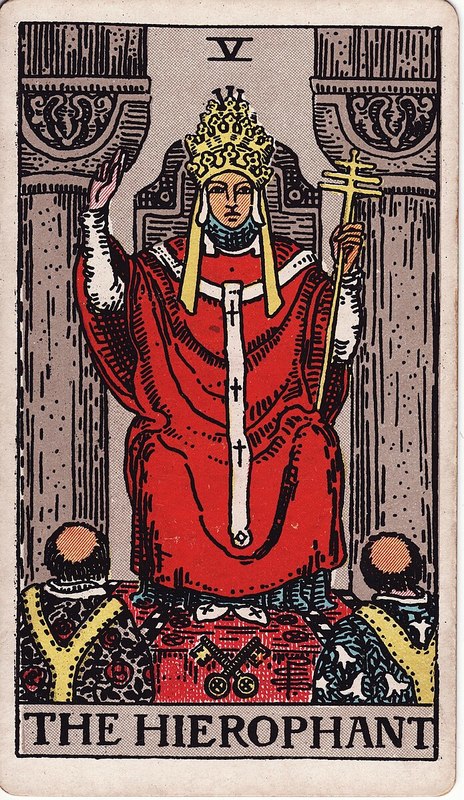
The Hierophant
The Hierophant depicts a imposing, stately figure with two subordinates kneeling in the foreground. The name "Hierophant" derives from the name used by the Golden Dawn for a higher-order officer who leads the initiation ritual for neophytes, as well as the grade rituals for initiates who have ascended further. Their position on the throne acts a representative of the Egyptian god Osiris, who is highly revered with the Golden Dawn. ^{13} The card therefore can be interpreted as a representation of this ritual, with the Hierophant leading the ceremony in Golden Dawn regalia, and the subordinates in the foreground representing the neophytes being initiated. Their flowery and leafy robes are akin to that of Fool's, which represents the newly initiated. Waite describes this card as the epitome of anything considered righteous and sacred. He went on to say that the figure on the throne is not only the leader of the earthly hierarchical order, but is also representing a higher, more esoteric order. ^{14} The sceptre that is being held acts as a bridge to this higher connectio , as it interrelates the Hierophant with the "divine light". ^{15} The figure in this card would be a Golden Dawn equivalent to a Pope.
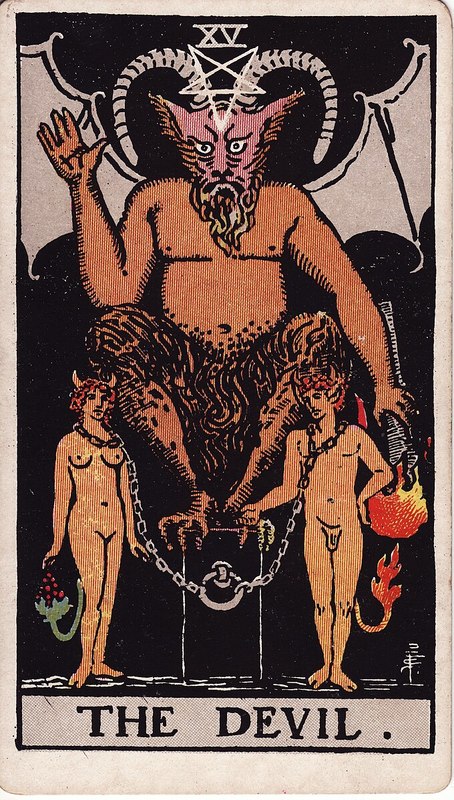
The Devil
In the style of the Golden Dawn, this card contains imagery pulled from different traditions, namely Christian in this instance. Two humanoid figures meant to represent Adam and Eve are shown chained to a type of podium, on which a horned devil is perched. The tails of these figures are ones of fire, and of forbidden fruit, further denoting the Christian influence. In Waite's description, the Devil card is meant as a juxtaposition to the Hierophant, the card representing a higher-order officer of the Golden Dawn. ^{16} As stated previously, Hierophants were key to ceremonies within Order, and were regarded as closer to enlightenment than most.^{17} The Christian symbolism acts to portray this juxtaposition through the use of fire, chains, and devilish entities to represent what the Golden Dawn would consider the opposite of their transcendent ideals. According to the Order, any kind of reverence towards the sovereignty and beauty of the material was considered false adoration and would be frowned upon.^{18} Another important symbol to note is the reversed pentagram found at the base of the horned animal's head. Pentagrams were traced by initiates during ritual meditations while quietly reciting or "vibrating" passages in Hebrew, to further ascend their consciousness.^{19} The reversal of this symbol further indicates that the overall symbolism behind this card is meant to represent the "sinner" an initiate would be if they were not to follow Golden Dawn traditions and ideals and instead focus on material pleasures.
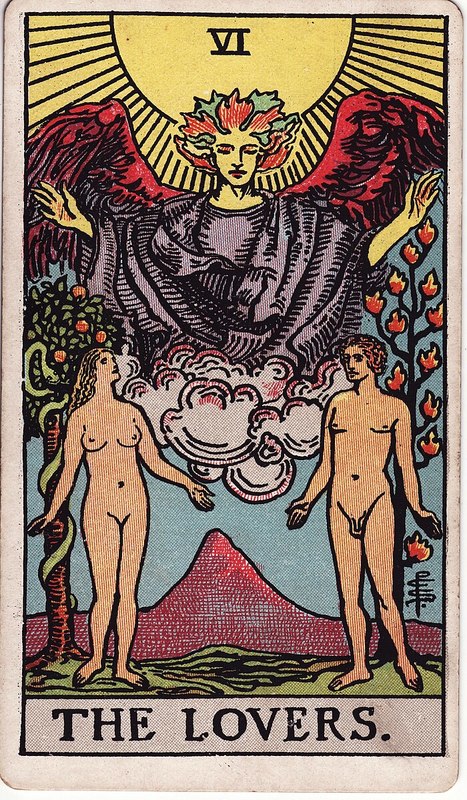
The Lovers
Within the Lovers card, there is another clear reference to the biblical figures Adam and Eve. The card features the two characters in a garden, with an angelic figure above. The Tree of Life is located in behind the figure representing Adam, and the Tree of Knowledge of Good and Evil is behind the figure representing Eve. The Tree of Life that the Golden Dawn would be referencing in this card is the Kabbalistic Tree of Life, an intricate diagram that portrays the emanation of the earthly realm to the divine realm. It was a visual representation of ten grades an initiate would pass through to reach enlightenment. ^{20} The Tree of Knowledge of Good and Evil also appears within Golden Dawn teachings, as it intertwines with the Tree of Life in the first seven grades.^{21} In place of fruit, the Tree of Life has flaming balls of fire in its branches, similar to the fiery hair of the angel depicted in the card. The fire on the Tree of Life is symbolizing its connection to the angel, and through that, the higher realm. The Tree of Knowledge is given a classical depiction, with fruit in its branches and a serpent coiled around the trunk. Given this depiction, the symbolism would follow suit and represent earthly temptation. The figures themselves according to Waite represent youth and innocence, untainted by the need to pursue pleasure in the material world. ^{22} Placing them in between temptation and ascension would therefore bring about the theme of choice between earthly temptations and raising one's consciousness. This card once again incorporates biblical symbolism to explain the choice initiates have in their spiritual journeys, and which "fruits" they are willing to take.
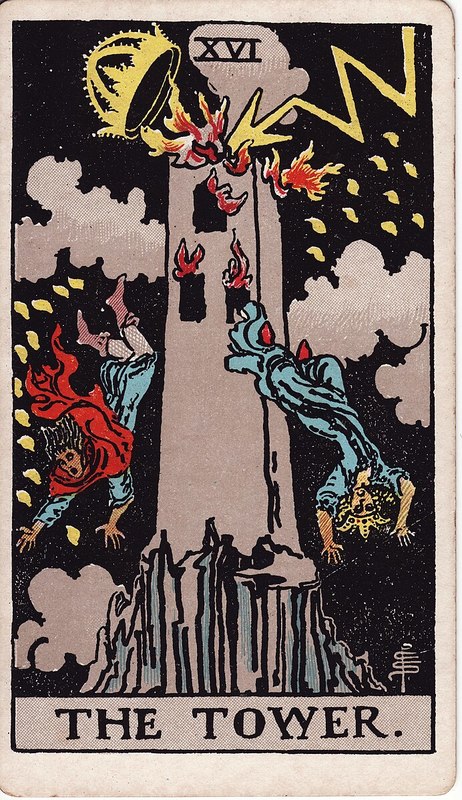
The Tower
Waite explains the Tower card as the downfall of a mind that is trying to seek understanding of esoteric things.^{23} In other words, it represents the destruction of one's ego as they delve deeper into esoterism. The mind is an extremely important asset to the members of the Golden Dawn, as their teachings are primarily based in accessing the power within the human consciousness, and letting go of ego is essential to bring this to fruition. Waite continues in saying that the Tower not only represents a rupture of the egotistical mind, but also a fall, similar to that in Christian tradition, into a more primal state. Similar to how the Devil card depicts worldly things as detestable, the Tower depicts what happens to an initiate if they were to choose playing into worldly vices over ascension. It can be viewed a reference to the Tower of Babbel, a biblical story in which there was an attempt to build a tower to heaven that was struck by divine lightning and was destroyed.^{24} The Tower in terms of the Golden Dawn is a man-made attempt at emulating the revered Kabbalistic Tree of Life but, just as in the biblical story, divine authority is not to be tampered with, so it will not stand. The destruction in the Tower card has two apparent meanings: it represents the rupture of a mind that is attempting to decode esoteric mysteries, and also the fight with pride and power over divine authority.^{25}
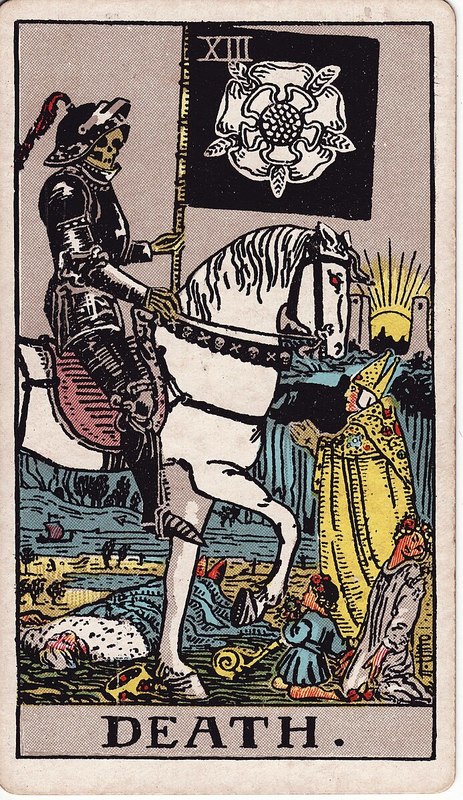
Death
The Death card depicts a rather morbid scene where an armoured skeleton calmly parades through a slew of dead bodies, with a sole robed figure begging for mercy. Death within the context of the Golden Dawn represents transformation. Waite explains that the reaping skeleton present in the card portrays the transformation from the lower realm of earth, to the higher realm amongst the angels. This is not meant to be depicted literally, it is meant to be interpreted as the mystical transformation of moving from one grade of the Order to the next.^{26} However, some interpretations did insinuate actual death. The beliefs surrounding death in the Golden Dawn were that of reincarnation, and through death an initiate would travel to a type of purgatory where they must learn lessons based on the events of their previous lifetime. This bears great resemblance to Buddhist beliefs. The soul of the initiate would either reincarnate, or elevate to a higher form of consciousness. It was believed that the last three grades of enlightenment were only accessible after death, so if a soul has finished enough cycles of reincarnation, the last three grades could then be accessed.^{27} The colour white is also a notable motif in this card, as it is found in the flag, the horse, and the skeleton. Golden Dawn traditions associate white with purity, so although the depictions on the card are quite grim, these transformations appear to be peaceful.^{28} The symbolism in the card no matter its interpretation points to the overall theme of transformation and ascending from one grade to the next.
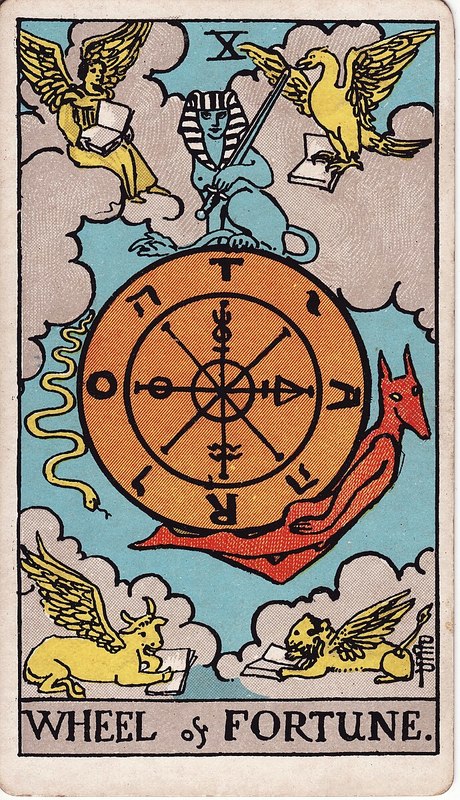
The Wheel of Fortune
The Wheel of Fortune card is a Golden Dawn depiction of karma and karmic cycles, a concept found in several different religious and spiritual belief systems. This is yet another example of the Order's tendency to take inspiration after other traditions. Egyptian symbolism, Hebrew letters, and the animals representing the four fixed signs of the zodiac, Taurus, Leo, Scorpio, and Aquarius can be found on the card. In terms of Golden Dawn teachings, the card represents a revolving staircase, where one will go around and around, through light and darkness.^{29} Waite describes this as "perpetual motion of a fluidic universe". with the sphinx atop the wheel representing equilibrium. In essence, it is the cyclical, cause and effect nature of karma. The Latin letters on the wheel spell "taro", which is possibly a reference to the cards themselves, being tarot cards. These letters, as noted by Waite can also be read backwards as "rota", as in rotation. The Hebrew characters in between spell the Divine Name in Judaism, signifying the Providence of higher powers as the cycle continuously turns.^{30} The four animals representing zodiac signs in each of the four corners of they sky shows the cyclical nature of the signs. Each day the constellations in view are changing, but they are bound to come back around again, just as fortune comes in and fades away. This once again brings about the adage: "as above, so below." Cycles are present in mundane life, but are also reflected in higher, karmic powers.^{31}
